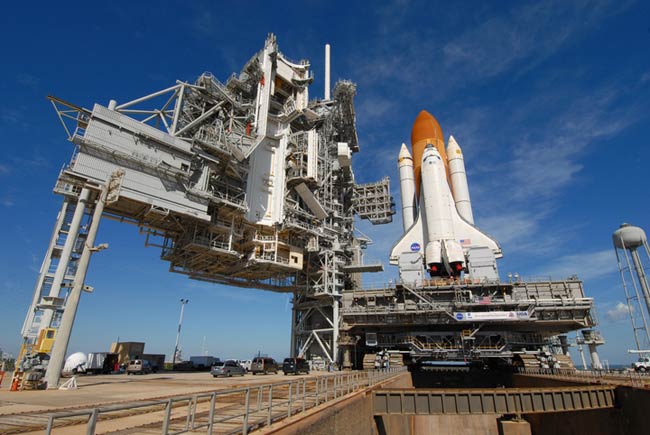Space Shuttle Discovery Set to Launch March 11

This story was updated at 3:50 p.m. EST.
Afterweeks of delays due to fuel valve concerns, NASA?s space shuttle Discovery is officiallyset to blast off on March 11, the space agency announced Friday.
Missionmanagers set the Wednesday launch date during a Flight Readiness Review atNASA?s Kennedy Space Center in Florida, where they decided the evidence wasfirm enough that suspectfuel valves should pose no problem for Discovery'splanned flight.
"Theyfelt they had all the data and information they needed to support launching onMarch 11," NASA spokesman Allard Beutel told SPACE.com. "Allthe extra testing gave engineers confidence enough to schedule a launchdate."
Discoveryis now officially poised to lift off for its STS-119 mission from a seasidelaunch pad at the Kennedy Space Center in Cape Canaveral, Fla., on Wednesday at9:20 p.m. EDT (0120 March 12 GMT). Commander Lee Archambault will lead a crewof seven astronauts on a two-week construction flight to the InternationalSpace Station to deliver a new set of solar array wings.
Fuelvalve delays
Originallyslated to launch Feb. 12, Discovery?s mission has been repeatedly delayed overconcerns that the shuttle?s three fuel control valves might be faulty. Thevalves function like pop-up lawn sprinklers to route gaseous hydrogen throughplumbing lines that lead to a hydrogen reservoir in the shuttle?s attachedexternal fuel tank. They ensure the spacecraft?s reservoir of liquid hydrogenpropellant is properly pressurized during launch.
Get the Space.com Newsletter
Breaking space news, the latest updates on rocket launches, skywatching events and more!
Theconcerns arose after a valve on NASA?s shuttle Endeavour cracked and chippedduring its November 2008 launch. The damage did not affect Endeavour?s launchinto orbit, but NASA wanted to be sure a similar problem would not endanger Discoveryor its astronaut crew.
"Wecompleted a lot of testing and a lot of analysis to understand the risks,"said Bill Gerstenmaier, NASA?s associate administrator for space operations, ina briefing today. "We're fully ready to go fly. It's time to step back fromthe issue of the day and think about all the other things we need for flightreadiness."
NASAordered a series of tests on the valves, and developed a new way to examinethem to search for any signs of cracks. The new method, which involves placinga valve in a magnetic field and measuring the strength of the field around it,revealed cracks much tinier than the width of a hair in some of the valves.After screening the three valves on Discovery, the mission management teamdecided to replace them with new valves that had been found to have no defects.
Engineersalso thoroughly modeled what would happen to the shuttle if any of the valvesdid crack during the launch, and found the chances of any serious damage to theorbiter were very remote.
"We'reputting valves in the vehicle that have no cracks," said John Shannon,NASA space shuttle program manager. "We also showed the risk on theconsequence side went down significantly from what we were speculating it wouldbe a couple weeks ago."
Launchwindows
DuringDiscovery'splanned 14-day mission, the astronauts are due to install the new solararrays to outfit the space station with enough power to run science experimentsand support new, expanded long-duration crews of six. The mission is set tofeature four spacewalks.
However,if the team is forced to delay Discovery's launch date because of weather,managers may decide to remove up to two spacewalks from the flight to shortenit, allowing them to launch as late as March 16. The spacewalks, or EVAs,wouldn't be cancelled, but just rescheduled for later missions.
"Wecould give those EVAs up if we needed to get more launch time," Shannonsaid.
Discovery'screw includes pilot Tony Antonelli and mission specialists Joseph Acaba, SteveSwanson, Richard Arnold, and John Phillips. Japan Aerospace Exploration Agencyastronaut Koichi Wakata will also ride aboard Discovery to take up position asa new flight engineer for the space station's Expedition 18. He will relieveNASA astronaut Sandra Magnus, who has been on the station for more than fourmonths. Wakata is set to return to Earth aboard next station shuttle mission,STS-127, which is targeted to launch in June 2009.
- New Show - NewSpace: The Orbital Industrial Revolution
- Video - Danger at the Pad! Shuttle Escape Training
- Video - Space Shuttle Bloopers
Join our Space Forums to keep talking space on the latest missions, night sky and more! And if you have a news tip, correction or comment, let us know at: community@space.com.

Clara Moskowitz is a science and space writer who joined the Space.com team in 2008 and served as Assistant Managing Editor from 2011 to 2013. Clara has a bachelor's degree in astronomy and physics from Wesleyan University, and a graduate certificate in science writing from the University of California, Santa Cruz. She covers everything from astronomy to human spaceflight and once aced a NASTAR suborbital spaceflight training program for space missions. Clara is currently Associate Editor of Scientific American. To see her latest project is, follow Clara on Twitter.









